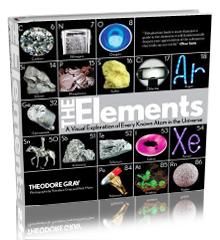Death on the breakfast table. | |||
| Sample Image | Spin Video | QuickTimeVR Rotation | |||
| Death on the breakfast table. Fiestaware was a very popular brand of ceramic tableware. Before the early 1940's the orange color of it was made with uranium in the glaze (uranium was used to get the color, not just accidentally). I think it's a good thing they stopped, because this thing is hot! It registers about 35,000 counts per minute, or almost 10 MREM/hour. Listen to the sound for this sample and contrast it with the other radioactive samples (uranium marbles, thorium mantle, americium smoke detector). This one has that "let's get out of here now before we fry" ring to it. To give a sense of how much radiation this is, if you held it in close proximity for 10 hours, you would double your yearly background radiation dose. If you kept it close for 20 days, you would have exceeded the yearly occupational exposure limit for nuclear power plant workers. (The preceding statement is pretty speculative: It's very difficult to determine how much of a dose you'd get, and it would depend very strongly on exactly how you were holding it. For example, holding it at arms length means the core of your body would get almost no exposure, and your hands are relatively insensitive to radiation. To really do some harm, you'd probably have to sit on it for a month or two.) On the other hand, I wouldn't want to eat out of it. Coincidentally right after it arrived, I came across an opportunity to scavenge about 3/4 of a ton of lead shielding from an abandoned hospital x-ray room. (I could have had the CAT scan machine too, but it was too big.) So I melted some down and made a 40 pound containment bowl to hold this little orange bowl. Overkill, yes, but then isn't this whole project just one huge case of overkill? You can see the lead bowl under lead. But after that I made a lead glass display case, which is where the bowl is now. If you're interested in collecting radioactive things like this, this is a book I strongly recommend. Here is a comment from its author about this dish: The Fiesta dishes may produce a lot of noise on your Geiger counter but they are not dangerous...at least not due to the uranium content. The deep, lustrous glaze, however, comes from lead and that is also a potential hazard. Both the lead and the uranium can leach out in acidic foods but lead is more readily retained in the body. The lead shielding around your Fiesta bowl is actually a greater hazard than the dish itself because of the concentration of lead and the ease with which it comes off when touched. The bountiful clicking of your Geiger counter is due to fairly weak beta emissions and doesn't penetrate the body to any appreciable depth. The glaze and your skin stop all alpha particles. The gamma activity is not significant. Radium bearing materials displayed on your website are far more hazardous and it is those items that should be meticulously sealed. Source: Charles and Susan Kunze Contributor: Charles and Susan Kunze Acquired: 30 July, 2002 Price: Donated Size: 5" Purity: <5% | |||
|

